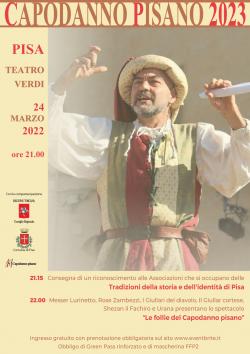
Next Friday, 25th March, Pisa, according to tradition, enters 2023, nine months ahead of the rest of the world. It is the appointment with the New Year's Eve in Pisano style that this year, after two years of forced virtual celebrations due to Covid-19, returns in presence. The main rendezvous will be in the Cathedral when the sunbeam ceremony marking the passage into the new year will take place at midday. A tradition that goes back to what is already attested by documents from the 10th century that testify how the city made the beginning of the new year coincide with the Annunciation to the Virgin Mary of the Incarnation of Jesus. To celebrate the date, the Municipality of Pisa has organised a series of initiatives. On Thursday 24th, the model of the ancient Republican Arsenals, restored thanks to the contribution of the Pisa Foundation, will be on display in the Town Hall, while in the evening there will be a show and an award ceremony for the associations involved in the city's traditions at the Verdi Theatre. On Friday 25th, in the morning, a short procession will precede the sunshine ceremony in the Cathedral at midday. In the afternoon, in Palazzo Gambacorti, the historical conference entitled "Porta San Marci De Guatholongo".
The programme
Thursday, March 24th, 5.00 pm, Atrium of Palazzo Gambacorti, Piazza XX Settembre: inauguration of the model restored with the contribution of the Pisa Foundation, representing the Republican Arsenals, made for the exhibition "Pisa and the Mediterranean", held in Pisa in 2003. Speakers: the Pisa Foundation, architect Roberto Masini, professor Gabriella Garzella, Francesco Capecchi.
9 p.m., Verdi Theatre: evening event "Pisa enters 2023". Awarding of the Pisan associations that deal with the traditions of history and identity of Pisa, followed by "Le Follie del Capodanno pisano", a show presented by the artists: Messer Lurinetto, I Giullari del Diavolo, Il Giullar cortese, Rose Zambezzi, Shezan il fachiro, Urana. (Free admission with compulsory booking at www.eventbrite.it. Green pass required).
Friday 25th March:
At 11.00 a.m. the historical procession will set off from Piazza dei Miracoli and then enter the Duomo where homage will be paid to the Madonna with prayers for Pisa. At midday, the start of the new year will be marked by the "Ceremony of the Sunbeam" when, entering through the window of the central nave of the Duomo, it will illuminate the egg-shaped shelf on the pillar next to the famous pulpit by Giovanni Pisano. At that point, it will be up to the mayor of Pisa, Michele Conti, to declaim the formula "To the greater glory of God, and invoking the intercession of the Blessed Virgin Mary and our Patron Saint Ranieri, we greet the year 2023". A tradition, revived in the 1980s, that harks back to the 10th century when the city made the start of the new year coincide with the Annunciation to the Virgin Mary of the Incarnation of Jesus.
The historical procession will consist of the Gonfalone accompanied by three valets from the Municipality, the Mayor, the votive candle with the four coats of arms of the city (Signum Rubicundum, Madonna in Majesty, Pisan Eagle, Pisan Cross) carried on the "trabiccolo" by two valets, the votive candle with the symbols of the "banderai dei Quarti" (Ponte, Mezzo, Foriporta, Kinzika) carried by hand by a valet, the Generale di Mezzogiorno with standard bearer and the Generale di Tramontana with standard bearer.
12 noon: Sunbeam ceremony.
5.00 p.m., Sala Baleari, Palazzo Gambacorti, Piazza XX Settembre: conference entitled "Porta San Marci De Guatholongo", organised by the Associazione Balestrieri di Porta San Marco. Speakers: Gianfranco Benvenuti, expert in Pisan history, and Renzo Ciangherotti, secretary of the Balestrieri di Porta San Marco association and expert in "Societates Populi" (green pass required).
Historical news
New Year's Eve in Pisan Style. Historical notes. Since the 10th century the Pisans made the beginning of the year coincide with the Annunciation (and therefore the Incarnation of Jesus), i.e. 9 months before 25 December. The result was the Anno Pisano ab Incarnatione Domini (or Christi). The first document dated in the Pisan style attesting to this dates back to 985. This date of the beginning of the year remained in force for centuries even in the lands belonging to the Republic of Pisa: the coast between Portovenere and Civitavecchia, Gorgona, Capraia, Elba, Pianosa, Corsica, Sardinia, Balearic Islands, Gaeta, Reggio Calabria, Tropea, Lipari, Trapani, Mazara, Tunisia, Algeria, Egypt, Palestine, Syria, the city of Azov (in the Sea of the same name, at the mouth of the River Don) and Constantinople, where the Pisans were the only westerners to be able to establish themselves, along with the Venetians.
Sunbeam ceremony. The moment of the changeover to the new year is different from the traditional one, and does not correspond to Midnight but to Midday, when a ray of sunlight from a window in the central nave of the Duomo illuminates the egg-shaped shelf on the pillar next to the famous pulpit by Giovanni Pisano.
Resumption of tradition. New Year's Eve in the Pisan style lasted until 20 November 1749, when the Grand Duke of Tuscany, Francis I of Lorraine, ordered that the year 1750 should begin in all the Tuscan states on the first day of the following January. Therefore, Pisa too had to conform to the use of the Gregorian calendar. It was not until the 1980s that the New Year's Day became popular again, and since then it has been celebrated with cultural initiatives in advance of the rest of the world.